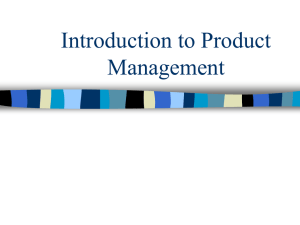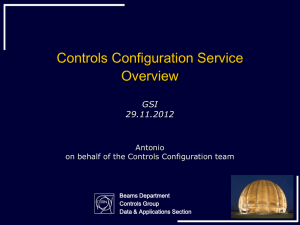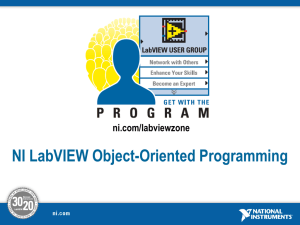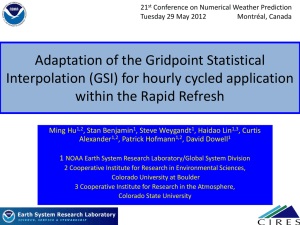Introduction to NI Actor Framework
advertisement
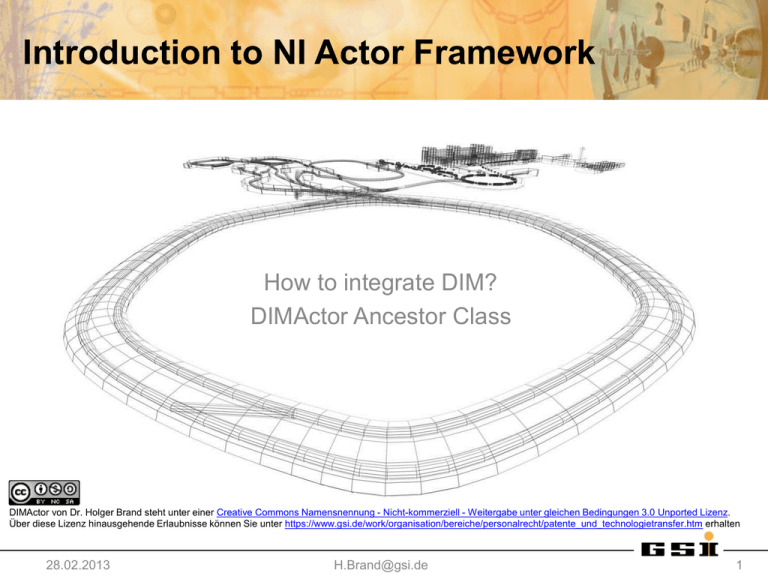
Introduction to NI Actor Framework How to integrate DIM? DIMActor Ancestor Class DIMActor von Dr. Holger Brand steht unter einer Creative Commons Namensnennung - Nicht-kommerziell - Weitergabe unter gleichen Bedingungen 3.0 Unported Lizenz. Über diese Lizenz hinausgehende Erlaubnisse können Sie unter https://www.gsi.de/work/organisation/bereiche/personalrecht/patente_und_technologietransfer.htm erhalten 28.02.2013 H.Brand@gsi.de 1 Agenda • Prerequisites • Motivation: Active objects • LVOOP • • • Pros & Cons Application NI Actor Framework • DIM • Example: • • DIMActor anchestor class DIMActor derived classes • • DIMDemoServer DIMDemoClient • How to extend existing Actors? • References 28.02.2013 H.Brand@gsi.de 2 Prerequisites • LabVIEW Basics 1 & 2 • Project Explorer • Libraries • Dataflow concept • Is knowledge about object oriented programming necessary? • No! • LabVIEW-Classes enables a developer to define his own data types, that provide much more abilities than (strict) type-definitions. • Experience with conventional OO programming languages, e.g. C++ or Java, is maybe confusing. 28.02.2013 H.Brand@gsi.de 3 LabVIEW Dataflow • No variables are existing in LabVIEW • There are data sources and data sinks! • A priori it is not clear from where data is originating! E.g.: • • • • Local and global variables are not really variables with respect to common sense, but different places in memory which are copied by LabVIEW Runtime-Engine asynchronously. This can lead to unintentional race conditions. Copies of data are created at wire forks. • • • The compiler is responsible to maintain a minimum number of copies to be used. Therefore LabVIEW is inherent thread-save! LabVIEW provides several options to transport data safely with respect to data flow without race conditions between different threads, VIs or loops. • • From front panel controls in case of interactive mode. From calling VI as parameter via connector pane. Queues, Notifications, FGV optionally protected by Semaphore etc. That’s all true for LabVIEW Objects, too! 28.02.2013 H.Brand@gsi.de 4 Pros of LVOOP Classes (in comparison to type definitions) • Encapsulation • • • • Attribute data is always private. It can be changed by class methods only. The internal data structure is hidden. Access rights: Public, Protected, Private, Community (friend) Modularity • • Each class has its own clearly defined responsibility. The public interface should be well defined. • • • Derived classes extend the attributes and methods of their ancestor class. Specialization • • Eases testability. Extensibility • • It should be modified with very good reason, only! Derived classes special the behavior of their ancestor class. LabVIEW Objects behave exactly like other LabVIEW data types • They are following the dataflow paradigm! 28.02.2013 H.Brand@gsi.de 5 LVOOP Cons - Solutions • • There are no real cons. (Copy-) Constructors and Destructors are not existing. • • • They are simply not necessary. LabVIEW Objects behave the same as other LabVIEW data types. Attributes are always private. • • They cannot be displayed or changed directly on the front panel. XControls are the solution for this problem. • • Polymorphic class-VIs are not supported. • • Parameters could be implemented as derived class of a common ancestor class. Parameters as Variant. • • Especially Variant-Attributes. Multiple inheritance is not supported. • • XControls can also be used as probes. An alternative is the Composition design pattern References to Objects • • Dataflow: Single Element Sized Queue Data Value Reference • 28.02.2013 Danger of deadlocks H.Brand@gsi.de 6 LVOOP Application Possible cases for the application of LVOOP classes: • Cluster or type definitions, which become potentially extended, can be replaced with classes. • • Derives classes add attributes to the ancestor class. Replacement of data type dependent (e.g. Enumeration) Case-Structures by dynamic dispatching. • • Dependent of the objects class the correct corresponding Overwrite-VI is called. Beispiel: Queued State-Maschine • Development of generic frameworks • • • The application layer uses base classes only. Details are implemented in derived classes. Actor Framework .............................................. 28.02.2013 H.Brand@gsi.de 7 NI Actor Framework Communication Scheme – Local Queues Launching Actors Asynchronous Communication via Queue • Actors are derived classes of Actor.lvclass • Caller-Enqueuer is used by Actor to send messages to the Caller. • Actor-Enqueuer is used by Caller to send messages to the Actor. • Messages are derived classes of Message.lvclass • Messages are calling public VIs of an Actor. • Actor-Messages can be generated automatically be using Tools>Actor Framework Message Maker. Linked Network Actor: https://decibel.ni.com/content/docs/DOC-24051 is using a nested actor maintaining networkstreams. 28.02.2013 H.Brand@gsi.de 8 Network Communication: DIM • • Originally developed at CERN (www.cern.ch/dim) DIM provides • • • DIM connects heterogenous systems. • • • Publisher-Subscriber Pattern Command Pattern Various operating systems Various programming languages LabVIEW-DIM-Interface is existing • http://wiki.gsi.de/cgi-bin/view/CSframework/LVDimInterface 28.02.2013 H.Brand@gsi.de 9 DIMActor – Project & Class Hierarchy • DIMActor.lvlib contains • DIMActor.lvclass derived from Actor.lvclass • DIMActor Messages • DIMActorDemo.lvlib contains • Server • • DIMDemoServer.lvclass derived from DIMActor.lvclass Server Messages • Client • • DIMDemoClient.lvclass derived from DIMActor.lvclass Client Messages • Application: Test.vi 28.02.2013 H.Brand@gsi.de 10 DIMActor Demo Application • • • • Initialize Caller to Actor Queue Initialize DIMDemoServer Initialize two DIMDemoClients Launch Actors 28.02.2013 • • • H.Brand@gsi.de Wait for Stop Sent Stop-Messages Report Error 11 Launch Actor 28.02.2013 H.Brand@gsi.de 12 DIMActor – Overwrite VI‘s Pre Launch Core.vi Stop Core.vi Actor Core.vi Dynamic Dispatch-VI: CastByteArrayAndDispatchMsg.vi 28.02.2013 H.Brand@gsi.de 13 DIMActor – Dynamic Dispatch VI Dynamic Dispatch-VI: CastByteArrayAndDispatchMsg.vi Example DIMDemoServer.lvclass: CastByteArrayAndDispatchMsg.vi 28.02.2013 H.Brand@gsi.de 14 DIMActor – Other VIs Add Command Start Serving Update Service Add Service Add Subscription 28.02.2013 Probe H.Brand@gsi.de 15 DIMDemoServer.lvclass:Actor Core.vi 28.02.2013 H.Brand@gsi.de 16 DIMDemoClient.lvclass:Actor Core.vi 28.02.2013 H.Brand@gsi.de 17 Extending existing Actors to use DIM • Inherit from DIMActor.lvclass instead of Actor.lvclass • Extend Actor Core.vi to add • Commands • Services • Subscriptions • Overwrite: CastByteArrayAndDispatchMsg.vi • For each Command and Subscription • • Typecast DIM byte-array to expected G data type Send corresponding (already existing) Message to self. • Publish Service data where necessary. • Use CoreLib.CallProcess.vi to send Messages to CS-Objects 28.02.2013 H.Brand@gsi.de 18 References • LabVIEW Menu -> Help -> Search the LabVIEW Help... -> Contents -> Fundamentals -> LabVIEW Object-Oriented Programming • LabVIEW Menu -> Help -> Find Examples -> Browse by Task -> Fundamentals -> Object-Oriented • LabVIEW Object-Oriented Programming: The Decisions Behind the Design • LabVIEW Object-Oriented Programming FAQ • Applying Common OO Design Patterns to LabVIEW • Actor Framework • Measurement Abstraction and Model-View-Controller (MVC) Project with Actor Framework in LabVIEW • HGF Baseclass Library • Mobile Agent System • Thanks to Stephen Mercer for his contributions to web documents & discussions 28.02.2013 H.Brand@gsi.de 19


